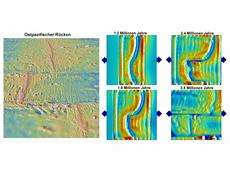Phenomenon of plate tectonics explained

Transform faults subdivide the mid-ocean ridge into segments. Up until now, it was thought that these faults were ruptures that formed in less stable crust areas. Taras Gerya has recorded a model of the dynamics that lead to the transform faults, which shows that what were assumed to be ruptures are in fact structures that have grown naturally.
The Earth's largest underwater mountain range, the mid-ocean ridge (MOR), is found at locations where new oceanic crust is created in the planet's oceans. It runs through the major oceans over a length of around 60,000 kilometres. The MOR demarcates the boundary between the two active plate edges at which the new crust is created and which move a few centimetres further apart each year. A specific feature of the MOR is that it is usually broken and shifted at intervals of a couple of hundred kilometres by what are known as transform faults. "These remarkable structures are still shrouded in mystery. Up to now, they were seen as a follow-on product from pre-existing weak zones in the crust," says Taras Gerya, a private lecturer at the Department for Earth Sciences at ETH Zurich, Switzerland. Unlike the area at the plate edges, no new crust is formed at the transform faults. The plates only shift in parallel to each other along the transform faults.
When transform faults develop
Gerya is specialized in the simulation of plate-tectonic processes and has now used high-resolution three-dimensional models to simulate why, how and under what physical conditions transform faults develop at the MOR.
The models show that transform faults develop where the oceanic crust grows asymmetrically, mostly in places where the active plate edges are diverging at a low to medium speed of around 4 to 6 centimetres per year. The asymmetric development stems from the fact that differing amounts of magma are added to the oceanic crust plates, which thus grow differently. This leads to dynamic instabilities in the crust plate boundary areas and consequently to the spontaneous development of transform faults from the "bends" that form along the MOR due to the differences in crust growth. The results of the study were recently published in the scientific magazine Science.
Snowflakes instead of fragments of broken glass
The simulations show in an impressive manner that the unevenly formed plate boundaries develop more and more "bends" over a few million years and can gradually develop into transform faults. This means that the transform faults are practically rotated and stretched parts of the MOR. The fact that these are plate growth structures rather than plate rupture structures is extremely significant: "Comparable to the difference between the growth structure of a snowflake and the rupture structure of a piece of broken glass," says Gerya.
More information: Gerya T: Dynamical Instability Produces Transform Faults at Mid-Ocean Ridges. Science 27 August 2010 329: 1047-1050. DOI: 10.1126/science.1191349 (in Reports)
Provided by ETH Zurich



















